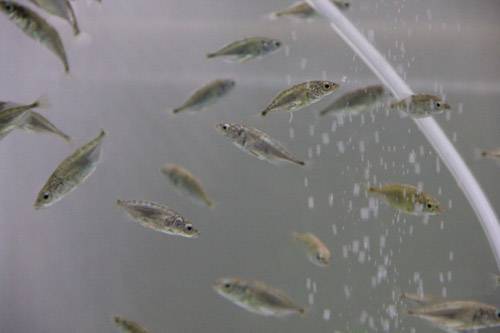
Microfishing is a fascinating angling pursuit that involves targeting and catching aquarium fish, shrimp, and other tiny aquatic species. It is a niche fishing technique that has gained popularity among anglers worldwide for its simplicity, accessibility, and the unique experience it offers. In this article, we will explore the world of microfishing, including its origins, equipment, techniques, and the joy it brings to anglers who appreciate the beauty of the small-scale aquatic world.
Origins of Microfishing:
Microfishing has its roots in Japan, where it is known as “tsurikawa” or “tenkara fishing.” Traditional Japanese anglers developed this technique centuries ago to catch small fish inhabiting mountain streams and ponds. Over time, the concept of microfishing has evolved and spread to other parts of the world, captivating anglers who seek a different kind of angling experience.
Equipment for Microfishing:
Microfishing requires minimalistic equipment, making it accessible to anglers of all ages and skill levels. Here are the essential items for microfishing:
a. Ultralight Fishing Rod: Choose a small and sensitive fishing rod, typically ranging from 3 to 7 feet in length, designed for ultralight fishing. A telescopic or fixed-length rod is suitable for microfishing, providing the necessary sensitivity to detect subtle bites.
b. Fine Fishing Line: Opt for a fine monofilament or fluorocarbon fishing line with a breaking strength ranging from 1 to 4 pounds. Lighter lines allow for delicate presentations and better sensitivity to detect bites from small fish.
c. Small Hooks: Select small hooks in the size range of #16 to #24, depending on the target species. Barbless hooks are preferable for easy hook removal and minimal harm to the fish.
d. Micro Floats or Indicators (optional): Micro floats or indicators can be used to detect bites, especially when fishing in flowing water or when targeting shy species. Choose small, sensitive floats that won’t overpower the lightweight setup.
Techniques and Strategies for Microfishing:
Microfishing requires a different approach compared to conventional angling techniques. Consider the following techniques and strategies to enhance your microfishing experience:
a. Location Selection: Look for aquatic planted habitats that support a variety of small fish and aquatic species. These include freshwater streams with aquatic plants, ponds, lakes, or even urban water bodies. Research local regulations and obtain necessary permits or licenses for fishing in specific areas.
b. Observation and Patience: Microfishing involves observing the aquatic environment closely. Look for signs of fish activity such as small disturbances or surface ripples. Patience is key, as microfish are often cautious and easily spooked. Approach the fishing spot quietly and with minimal disturbance.
c. Small Baits and Lures: Use tiny baits and lures that mimic the natural food sources of small fish. Live baits such as small worms, insects, or crustaceans work well. Alternatively, artificial micro lures can be used, such as tiny jigs, soft plastics, or flies.
d. Delicate Presentation: Microfish have small mouths and are more cautious when approaching baits. Present the bait delicately, allowing it to drift naturally or gently twitching it to attract their attention. Avoid aggressive movements that may scare the fish away.
e. Species Identification and Conservation: Take the time to learn about the different species of microfish and aquatic or aquarium plants in your area. Proper identification allows you to appreciate the diversity of these small creatures and practice responsible catch-and-release techniques to conserve their populations.

When it comes to aquarium fish, most enthusiasts envision vibrant and colorful species that add a lively touch to their aquatic display. However, there is a lesser-known side to the aquarium hobby that focuses on tiny fish species—microfishing fish for aquariums. These miniature aquatic gems offer a unique and captivating experience, showcasing the beauty and intricacies of the small-scale aquatic world.
Celestial Pearl Danio (Danio margaritatus):
Also known as the Galaxy Rasbora or simply the “CPD,” the Celestial Pearl Danio is a stunning microfish species native to Southeast Asia. With its shimmering blue-green body and striking red markings, this fish adds a touch of elegance to any aquarium. The CPD is peaceful, making it an excellent choice for community tanks. Provide them with a well-planted aquarium with soft, slightly acidic water and moderate lighting.
Ember Tetra (Hyphessobrycon amandae):
The Ember Tetra is a tiny characin species originating from Brazil. Its vibrant orange-red coloration and active schooling behavior make it a popular choice among microfishing enthusiasts. These small fish thrive in groups, so it’s recommended to keep them in a school of at least six individuals. Provide them with a well-maintained aquarium with ample hiding places and gentle water flow. The Ember Tetra adapts well to a variety of water parameters, but slightly acidic and soft water conditions are preferable.
Mosquito Rasbora (Boraras brigittae):
The Mosquito Rasbora, also known as the Chili Rasbora or Brigittae Rasbora, is a minute fish species that hails from Southeast Asia. Its vibrant red coloration and delicate appearance make it a sought-after addition to nano and planted aquariums. These tiny fish are peaceful and should be kept in groups of at least six individuals to encourage natural behaviors. They appreciate a densely planted aquarium with soft, slightly acidic water conditions. Pay attention to water quality and maintain stable parameters to ensure their well-being.
Dwarf Pencilfish (Nannostomus marginatus):
The Dwarf Pencilfish is a captivating microfish species native to South America. Known for its slender body and elongated fins, it adds grace and charm to aquarium setups. This species prefers a well-planted aquarium with subdued lighting and plenty of hiding places. Keep them in groups of at least six to reduce stress and encourage natural behaviors. Provide them with soft, slightly acidic water conditions to mimic their natural habitat.
Least Killifish (Heterandria formosa):
The Least Killifish, also called the Dwarf Livebearer, is a tiny livebearing fish species native to North America. It has a peaceful temperament and exhibits interesting behaviors, making it a fascinating addition to small aquariums. The Least Killifish thrives in well-maintained aquariums with ample hiding places and plants. It adapts well to a wide range of water parameters, but slightly alkaline to neutral water conditions are preferred. Keep them in a small group, ensuring a mix of males and females for breeding.
Scarlet Badis (Dario dario):
The Scarlet Badis is a strikingly beautiful microfish species originating from India and Bangladesh. The males exhibit vibrant red and blue coloration, making them a captivating sight in the aquarium. These fish prefer densely planted aquariums with gentle water movement and hiding places







